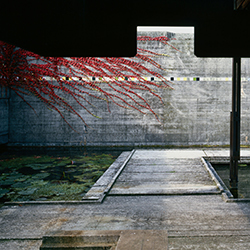
Carlo Scarpa / Sekiya Masaaki
Tracce d’architettura nel mondo di un fotografo giapponese
| - |
|---|
| Treviso, Ca’ Scarpa |
L’opera di Carlo Scarpa colta e interpretata da Sekiya Masaaki, ma anche l’architettura stessa come compresa all’interno del mondo di immagini del fotografo giapponese.
È attorno a queste due posizioni che ruota Carlo Scarpa / Sekiya Masaaki. Tracce d’architettura nel mondo di un fotografo giapponese, la mostra fotografica, organizzata dalla Fondazione Benetton Studi Ricerche, a cura di J.K. Mauro Pierconti, storico dell’architettura, che inaugurerà venerdì 14 aprile alle ore 18 e che sarà aperta fino a domenica 16 luglio a Ca’ Scarpa a Treviso, una delle sedi espositive della Fondazione Benetton e di cui J. K. Mauro Pierconti è curatore.
Carlo Scarpa (1906-1978) e Sekiya Masaaki (1942-2002) dunque. Ma non solo. La carriera professionale di Sekiya ha conosciuto varie fasi, tutte incentrate sulla fotografia: da fotografo di architettura a consulente per la progettazione architettonica, fino a diventare promotore di fotografi di talento non ancora conosciuti e quindi bisognosi di sostegno e pubblicità. E l’esposizione darà conto anche di questi aspetti della sua attività.
La mostra raccoglie 85 fotografie, 54 a colori e 31 in bianco e nero, e si articola in quattro sezioni, distribuite nei vari piani di Ca’ Scarpa, spazio recentemente restaurato dall’architetto Tobia Scarpa a partire da una chiesa monastica che sorgeva proprio nel cuore della città di Treviso. Qui una grande struttura metallica, già presente all’interno dell’edificio, è stata recuperata e riutilizzata per suddividere il volume interno in quattro piani, uguali e indipendenti, serviti da una nuova scala sospesa.
La prima sezione, al piano terra, raccoglie grandi immagini che rappresentano l’attività di Sekiya Masaaki come promotore di fotografi di talento. È il caso di Hattori Aiko, fotografa di strada, che ha realizzato una serie di reportage sulla vita di Tōkyō negli anni ottanta. Due i temi trattati dalla fotografa: il mondo giovanile, ritratto nelle sue espressioni ed esuberanze, e quello del lavoro, serio e rigoroso. Due realtà spesso considerate agli antipodi, ma ugualmente portatrici di energia, vitalità e solidarietà. E il teatro di molte loro avventure è, appunto, la strada. Si tratta di immagini ancora inedite, ritrovate nell’archivio di Sekiya, forti dell’immediatezza e della vivacità di questo tipo di fotografie: i grandi pannelli in mostra hanno un impatto immediato, catturando lo sguardo e segnando al tempo stesso il percorso dell’esposizione che si muove ondivago tra le strutture espositive, portando a scoprire, nel retro di quelle grandi stampe, le fotografie nel loro formato originale: un doppio timbro, dunque; e un doppio percorso. Lo spettatore è portato così a immergersi in quelle immagini, dove ognuna racconta una storia, rappresenta delle vite, e senza necessità di parole o testi.
La grande scala funge da elemento di stacco e di separazione tra sezioni diverse e successive.
Al primo piano trovano spazio la seconda e la terza sezione della mostra, dedicate all’attività di Sekiya come fotografo d’architettura.
Nella seconda sezione è allestita una selezione di scatti del suo primo lavoro fotografico, quello sulle rovine di Angkor Wat in Cambogia, realizzato quando era ancora uno studente universitario. Le fotografie sono quasi tutte in bianco e nero. La ricerca è volta a scavare in quelle rovine consumate dal tempo e divorate dalla foresta: resti di un mondo perduto che, attraverso il nostro sguardo, ritornano potentemente alla vita.
La terza sezione è invece dedicata al lavoro più completo e importante dell’intera carriera di Sekiya in quest’ambito: l’opera monografica su Otto Wagner a Vienna, pubblicata nel 1998. La qualità del lavoro, la chiarezza tecnica (esposizione, contrasto, fuoco), la volontà e la finezza intellettuale espresse attraverso il taglio delle inquadrature emergono nella successione di scatti, dalla scelta dei dettagli, realizzati usando addirittura gru in tempi nei quali non esistevano i droni. In questo modo, Sekiya ci offre delle visuali dei grandi edifici di Wagner, come le residenze sulla Linke Weinzeile o una veduta aerea della chiesa di S. Leopoldo “am Steinhof”, del tutto sorprendenti.
Gli ultimi due piani, in cui si snoda la quarta sezione dell’esposizione, sono invece dedicati all’opera di Carlo Scarpa, il lavoro che ha impegnato Sekiya fino alla morte, avvenuta nel 2002, quindi incompiuto e frammentario. Infatti, Sekiya non riesce a riprendere l’intera opera dell’architetto veneziano. Eppure, nel suo archivio ci sono alcune migliaia di lastre fotografiche, ben più di mille per la sola Tomba Brion, ripresa in successive campagne.
Le migliaia di fotografie rivelano dunque una volta di più il suo modo di operare, fatto di campagne di ripresa, seguite da un lungo lavoro di correzione e di selezione, e quindi da nuove riprese e nuove correzioni: un processo di continuo raffinamento e di progressiva selezione che, se da un lato cerca di catturare e trattenere il mutare del tempo e delle stagioni, dall’altro si sforza di definire con precisione i parametri di esposizione e il taglio dell’inquadratura. Queste fotografie offrono l’opportunità di ragionare una volta di più sull’opera di Carlo Scarpa e, allo stesso tempo, l’esposizione si propone di mostrare al visitatore una selezione – la più ampia possibile – degli scatti di Sekiya, in parte anche proiettati nell’ultimo piano di Ca’ Scarpa.
L’incompletezza, infatti, nulla toglie all’interesse e allo stimolo che queste fotografie suscitano di guardare con occhi rinnovati la ricchezza dell’opera architettonica, così come attesta il volume connesso all’esposizione: Carlo Scarpa / Sekiya Masaaki. Tracce d’architettura nel mondo di un fotografo giapponese / Traces of architecture in the world of a Japanese photographer (Fondazione Benetton Studi Ricerche-Antiga Edizioni).
